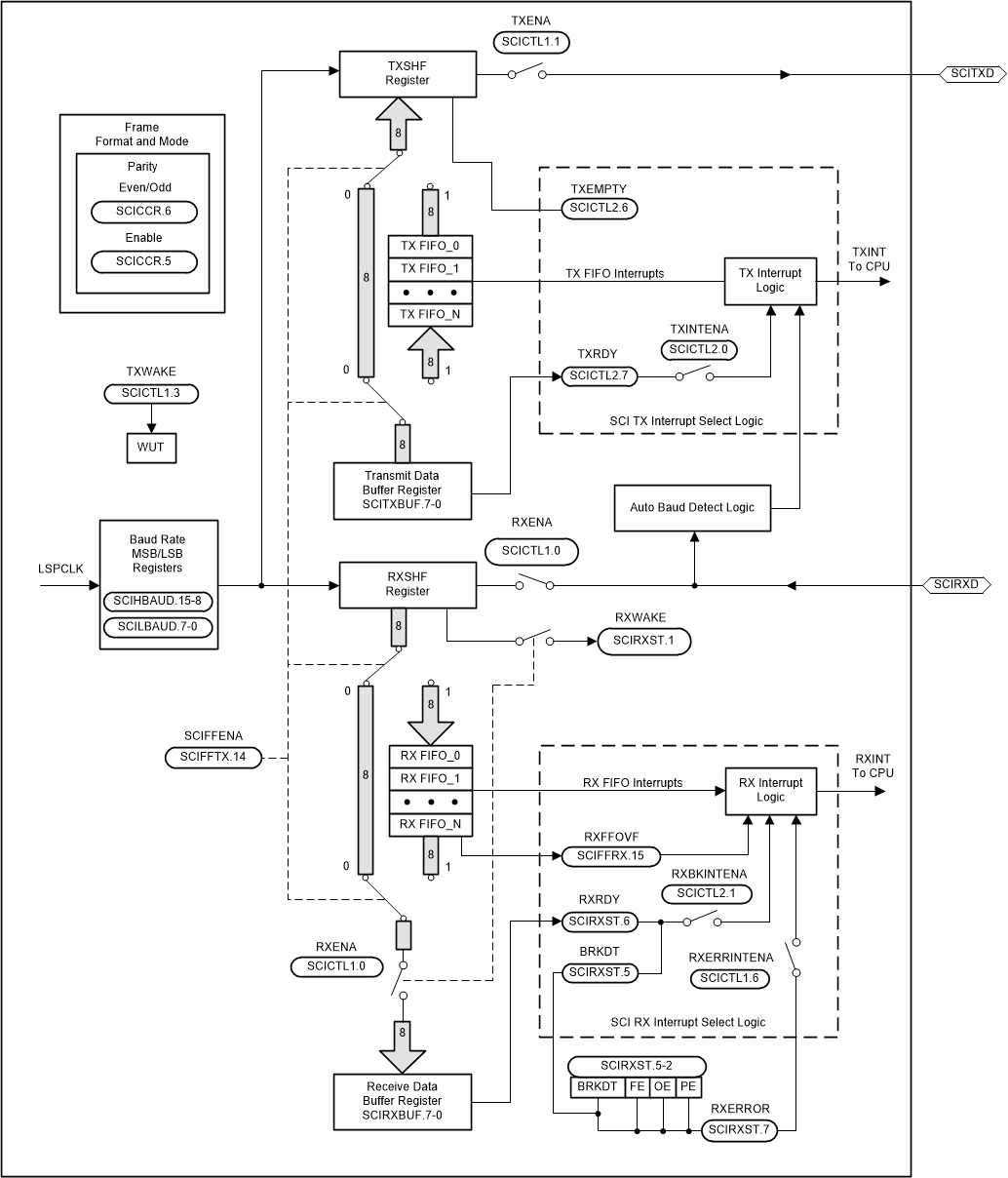SPRS584Q April 2009 – January 2024 TMS320F28030 , TMS320F28030-Q1 , TMS320F28031 , TMS320F28031-Q1 , TMS320F28032 , TMS320F28032-Q1 , TMS320F28033 , TMS320F28033-Q1 , TMS320F28034 , TMS320F28034-Q1 , TMS320F28035 , TMS320F28035-Q1
PRODUCTION DATA
- 1
- 1 Features
- 2 Applications
- 3 Description
- 4 Device Comparison
- 5 Pin Configuration and Functions
-
6 Specifications
- 6.1 Absolute Maximum Ratings
- 6.2 ESD Ratings – Automotive
- 6.3 ESD Ratings – Commercial
- 6.4 Recommended Operating Conditions
- 6.5 Power Consumption Summary
- 6.6 Electrical Characteristics
- 6.7 Thermal Resistance Characteristics
- 6.8 Thermal Design Considerations
- 6.9 JTAG Debug Probe Connection Without Signal Buffering for the MCU
- 6.10 Parameter Information
- 6.11 Test Load Circuit
- 6.12 Power Sequencing
- 6.13 Clock Specifications
- 6.14 Flash Timing
-
7 Detailed Description
- 7.1
Overview
- 7.1.1 CPU
- 7.1.2 Control Law Accelerator (CLA)
- 7.1.3 Memory Bus (Harvard Bus Architecture)
- 7.1.4 Peripheral Bus
- 7.1.5 Real-Time JTAG and Analysis
- 7.1.6 Flash
- 7.1.7 M0, M1 SARAMs
- 7.1.8 L0 SARAM, and L1, L2, and L3 DPSARAMs
- 7.1.9 Boot ROM
- 7.1.10 Security
- 7.1.11 Peripheral Interrupt Expansion (PIE) Block
- 7.1.12 External Interrupts (XINT1–XINT3)
- 7.1.13 Internal Zero Pin Oscillators, Oscillator, and PLL
- 7.1.14 Watchdog
- 7.1.15 Peripheral Clocking
- 7.1.16 Low-power Modes
- 7.1.17 Peripheral Frames 0, 1, 2, 3 (PFn)
- 7.1.18 General-Purpose Input/Output (GPIO) Multiplexer
- 7.1.19 32-Bit CPU-Timers (0, 1, 2)
- 7.1.20 Control Peripherals
- 7.1.21 Serial Port Peripherals
- 7.2 Memory Maps
- 7.3 Register Maps
- 7.4 Device Emulation Registers
- 7.5 VREG/BOR/POR
- 7.6 System Control
- 7.7 Low-power Modes Block
- 7.8 Interrupts
- 7.9
Peripherals
- 7.9.1 Control Law Accelerator (CLA) Overview
- 7.9.2 Analog Block
- 7.9.3 Detailed Descriptions
- 7.9.4 Serial Peripheral Interface (SPI) Module
- 7.9.5 Serial Communications Interface (SCI) Module
- 7.9.6 Local Interconnect Network (LIN)
- 7.9.7 Enhanced Controller Area Network (eCAN) Module
- 7.9.8 Inter-Integrated Circuit (I2C)
- 7.9.9 Enhanced PWM Modules (ePWM1/2/3/4/5/6/7)
- 7.9.10 High-Resolution PWM (HRPWM)
- 7.9.11 Enhanced Capture Module (eCAP1)
- 7.9.12 High-Resolution Capture (HRCAP) Module
- 7.9.13 Enhanced Quadrature Encoder Pulse (eQEP)
- 7.9.14 JTAG Port
- 7.9.15 General-Purpose Input/Output (GPIO) MUX
- 7.1
Overview
- 8 Applications, Implementation, and Layout
- 9 Device and Documentation Support
- 10Revision History
- 11Mechanical, Packaging, and Orderable Information
Package Options
Mechanical Data (Package|Pins)
Thermal pad, mechanical data (Package|Pins)
Orderable Information
7.9.5 Serial Communications Interface (SCI) Module
The devices include one serial communications interface (SCI) module (SCI-A). The SCI module supports digital communications between the CPU and other asynchronous peripherals that use the standard nonreturn-to-zero (NRZ) format. The SCI receiver and transmitter are double-buffered, and each has its own separate enable and interrupt bits. Both can be operated independently or simultaneously in the full-duplex mode. To ensure data integrity, the SCI checks received data for break detection, parity, overrun, and framing errors. The bit rate is programmable to over 65000 different speeds through a 16-bit baud-select register.
Features of each SCI module include:
- Two external pins:
- SCITXD: SCI transmit-output pin
- SCIRXD: SCI receive-input
pin Note:Both pins can be used as GPIO if not used for SCI.
- Baud rate programmable to 64K different rates:

- Data-word format
- One start bit
- Data-word length programmable from 1 to 8 bits
- Optional even/odd/no parity bit
- One or 2 stop bits
- Four error-detection flags: parity, overrun, framing, and break detection
- Two wake-up multiprocessor modes: idle-line and address bit
- Half- or full-duplex operation
- Double-buffered receive and transmit functions
- Transmitter and receiver
operations can be accomplished through interrupt-driven or polled algorithms
with status flags.
- Transmitter: TXRDY flag (transmitter-buffer register is ready to receive another character) and TX EMPTY flag (transmitter-shift register is empty)
- Receiver: RXRDY flag (receiver-buffer register is ready to receive another character), BRKDT flag (break condition occurred), and RX ERROR flag (monitoring four interrupt conditions)
- Separate enable bits for transmitter and receiver interrupts (except BRKDT)
- NRZ (nonreturn-to-zero) format
Note:All registers in this module are 8-bit registers that are connected to Peripheral Frame 2. When a register is accessed, the register data is in the lower byte (7–0), and the upper byte (15–8) is read as zeros. Writing to the upper byte has no effect.
Enhanced features:
- Auto baud-detect hardware logic
- 4-level transmit/receive FIFO
The SCI port operation is configured and controlled by the registers listed in Table 7-29.
| NAME(1) | ADDRESS | SIZE (x16) | EALLOW PROTECTED | DESCRIPTION |
|---|---|---|---|---|
| SCICCRA | 0x7050 | 1 | No | SCI-A Communications Control Register |
| SCICTL1A | 0x7051 | 1 | No | SCI-A Control Register 1 |
| SCIHBAUDA | 0x7052 | 1 | No | SCI-A Baud Register, High Bits |
| SCILBAUDA | 0x7053 | 1 | No | SCI-A Baud Register, Low Bits |
| SCICTL2A | 0x7054 | 1 | No | SCI-A Control Register 2 |
| SCIRXSTA | 0x7055 | 1 | No | SCI-A Receive Status Register |
| SCIRXEMUA | 0x7056 | 1 | No | SCI-A Receive Emulation Data Buffer Register |
| SCIRXBUFA | 0x7057 | 1 | No | SCI-A Receive Data Buffer Register |
| SCITXBUFA | 0x7059 | 1 | No | SCI-A Transmit Data Buffer Register |
| SCIFFTXA(2) | 0x705A | 1 | No | SCI-A FIFO Transmit Register |
| SCIFFRXA(2) | 0x705B | 1 | No | SCI-A FIFO Receive Register |
| SCIFFCTA(2) | 0x705C | 1 | No | SCI-A FIFO Control Register |
| SCIPRIA | 0x705F | 1 | No | SCI-A Priority Control Register |
For more information on the SCI, see the Serial Communications Interface (SCI) chapter in the TMS320F2803x Real-Time Microcontrollers Technical Reference Manual.
Figure 7-33 shows the SCI module block diagram.
 Figure 7-33 Serial
Communications Interface (SCI) Module Block Diagram
Figure 7-33 Serial
Communications Interface (SCI) Module Block Diagram